The world’s most colourful destinations are a feast for the eyes
Bright and beautiful spots around the world
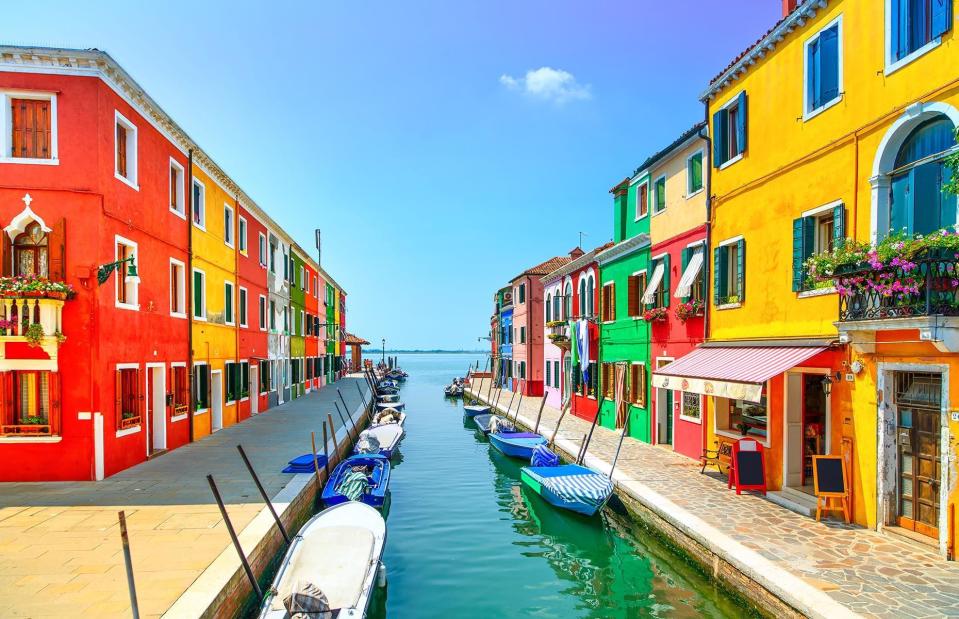
StevanZZ/Shutterstock
There's no denying that a colour-filled and sunny getaway can cheer the soul. We've selected a few of our favourite technicolour places and spaces that make for an eye-catching escape. Grab the shades as we tour the world's most colourful destinations...
Nyhavn, Copenhagen, Denmark
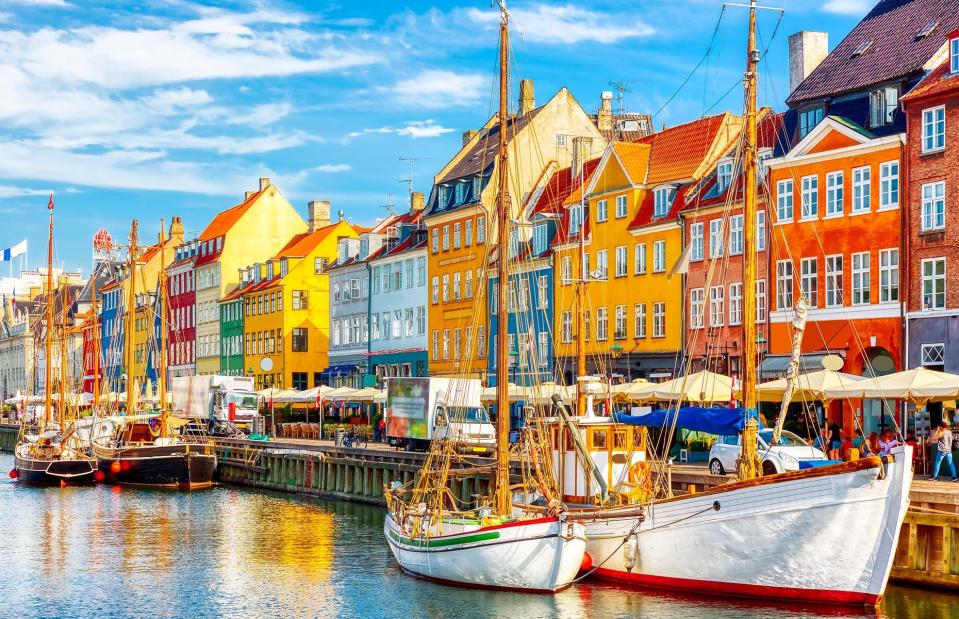
Nikolay Antonov/Shutterstock
Built in the 17th and 18th centuries, the brightly coloured houses that line Nyhavn’s canal might be a beloved sight in the city today, but they weren't always this salubrious. The fairy-tale-like area was originally home to the city’s poor and rowdy pubs that were frequented by inebriated sailors, but today it's Copenhagen's most famous sight, filled with high-end restaurants and cafés.
Fly Geyser, Nevada, USA
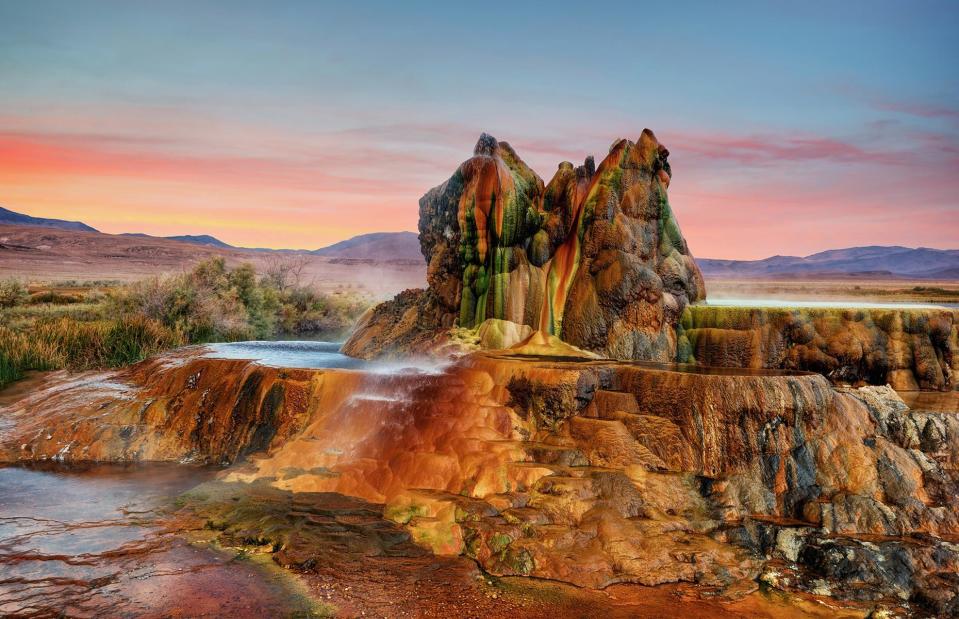
Lukas Bischoff Photograph/Shutterstock
The kaleidoscopic Fly Geyser in Black Rock Desert is a totally unique sight as it was actually formed due to human error. In the 1960s, a geothermal energy company drilled on the site in the hope of striking a usable power source. The water the workmen hit wasn't warm enough but they failed to properly seal the opening they made. Today, the geyser still spews water and steam, and the brilliant colours are formed by the algae it's covered in.
Lavender fields, Provence, France
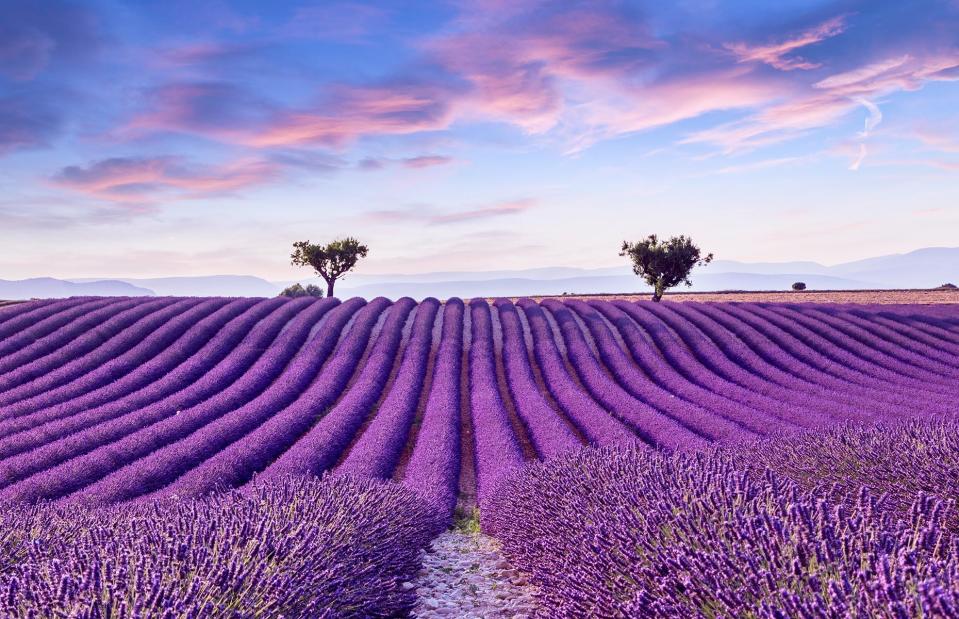
Fesus Robert/Shutterstock
The lavender fields of France's Provence region explode in a fragrant haze of purple from around mid-June up until August (although they're at their peak in early July). The biggest concentration of lavender fields is on the high plateau around Sault, at the foot of the Mont Ventoux and around Apt and Gordes. Lavender is an important part of life in Provence as it has countless uses, from beauty products and soaps, to aromatherapy, natural remedies and cooking.
Aveiro, Portugal
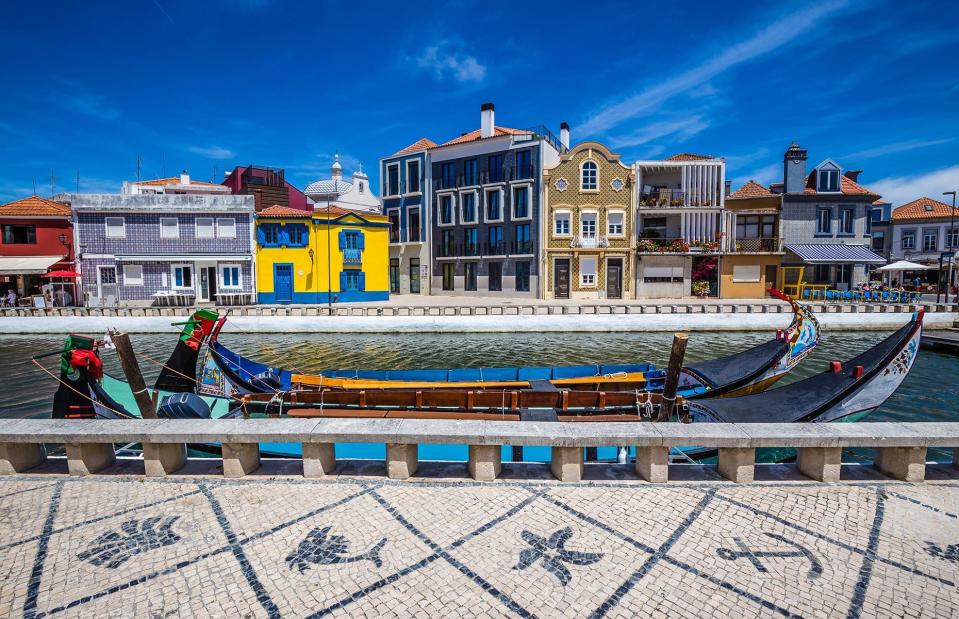
Zdenek Matyas Photography/Shutterstock
You could be forgiven for mistaking Aveiro for Venice, especially given the maze-like canals flanked by colourful moliceiros – canal cruise boats traditionally used for seaweed harvesting. In reality, this pretty city lies between Porto and Lisbon, situated on the edge of an extensive lagoon system right by the Atlantic Ocean. Aside from the boats, it's best characterised by Art Nouveau architecture that incorporates intricate tilework as well as the nearby coast, which is dotted with stripy pastel-hued beach huts.
Rainbow Mountain, Peru
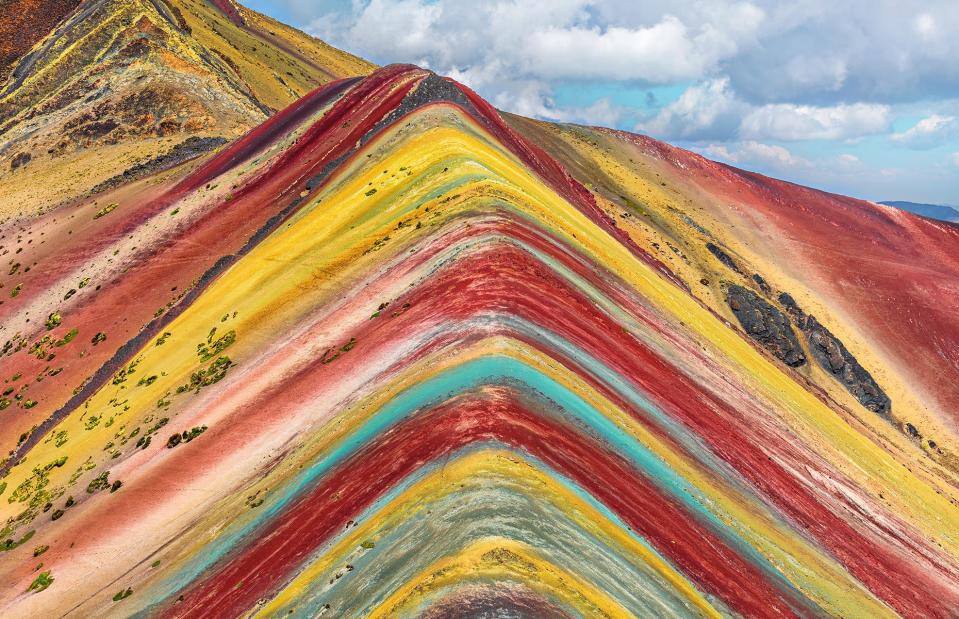
May_Lana/Shutterstock
This multicoloured wonder, called Vinicunca and known as Rainbow Mountain, in the Peruvian Andes is not man-made despite what its perfectly symmetrical layers might make you think. The colourful bands, ranging from pink and red to yellow and green, are the result of sedimentary layers forming from mineral deposits over the years.
Positano, Amalfi, Italy

lukaszimilena/Shutterstock
Dramatically perched on the cliffs of the Amalfi Coast, Positano is a postcard-perfect town. Its stony streets are lined with flowering lemon, orange and olive groves, not to mention stunning architecture, as they wind down to a small, but perfectly formed beach and the jewel-blue Mediterranean Sea. In idyllic Italian fashion, these streets are also filled with alluring restaurants, boutiques and chic hotels.
Nuuk, Greenland
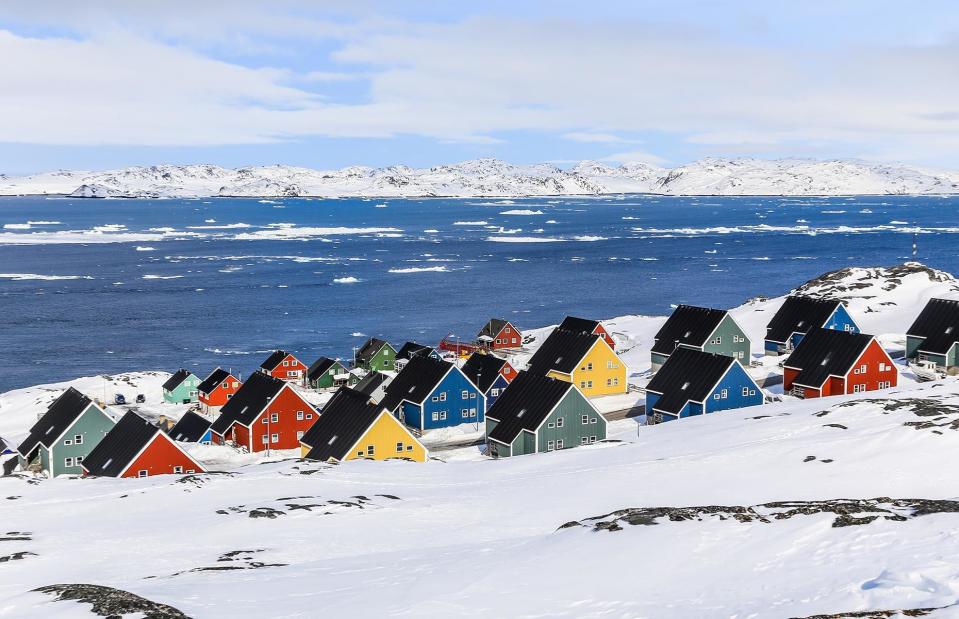
Vadim Nefedoff/Shutterstock
These brightly coloured houses hark back to the early 17th century when timber kits were sent up from mainland Scandinavia. Each colour represented the building’s function – commercial houses were red, hospitals were yellow, police stations were black, fish factories were blue and the telephone company was green. These days, locals like to combine the old tradition with modern colours like pink, purple and orange, which look especially great in contrast with the sparkling white snow.
Plitviče Lakes National Park, Croatia

mpaniti/Shutterstock
Covering almost 115 square miles (298sq km), Plitviče Lakes National Park is found near the Bosnia and Herzegovina border, two hours south by car from Zagreb in Croatia. The park, founded in 1949, is famous for its collection of 16 crystal-clear, colour-changing lakes – they morph between shades of green and blue due to their high mineral content – plus over 90 waterfalls. It's a truly magical landscape.
Jaipur, Rajasthan, India

mickyteam/Shutterstock
Talk about opulence. In 1853, ruler Maharaja Sawai Ram Singh had the whole city of Jaipur painted pink for a visit from Edward, Prince of Wales, the future king of England. To this day, the Rajasthani capital retains its signature rose-tinted hue across historic buildings, homes and shops, and is one of the stops on the popular Golden Triangle circuit. Pictured here is Patrika Gate, one of the seven gates adorning Jaipur's city walls.
Willemstad, Curaçao
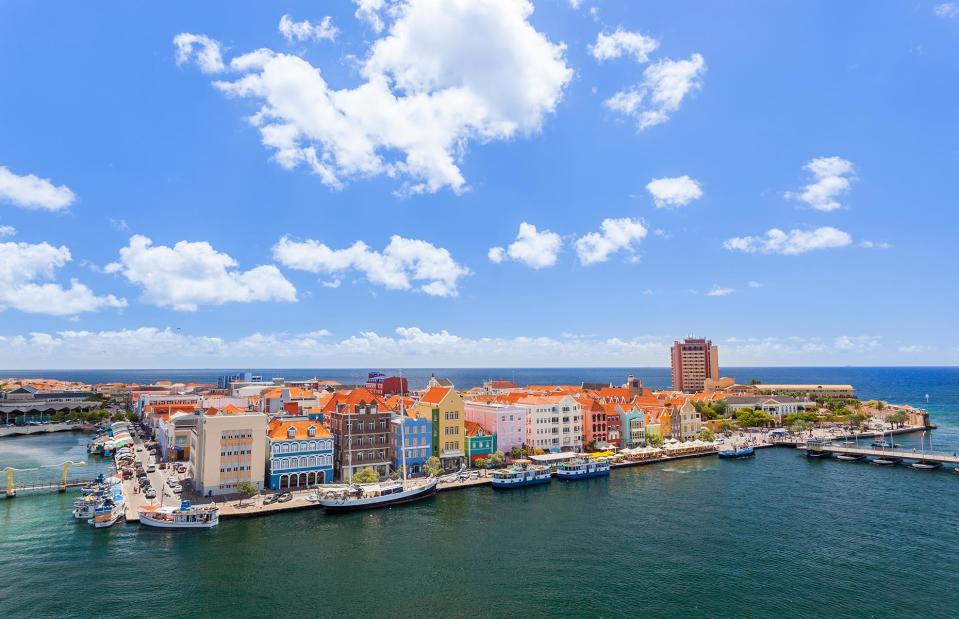
emperorcosar/Shutterstock
The history of Willemstad's coloured houses sounds like an urban legend, but the buildings in this UNESCO-protected Caribbean town were initially painted in an attempt to cure a headache. Back when the Dutch ruled Curaçao, the governor was convinced his migraines were caused by the tropical sun’s rays reflecting off the whitewashed buildings. All citizens were commanded to paint their homes anything but blinding white, resulting in this pastel rainbow paradise.
Geyzernoye Lake, Siberia, Russia
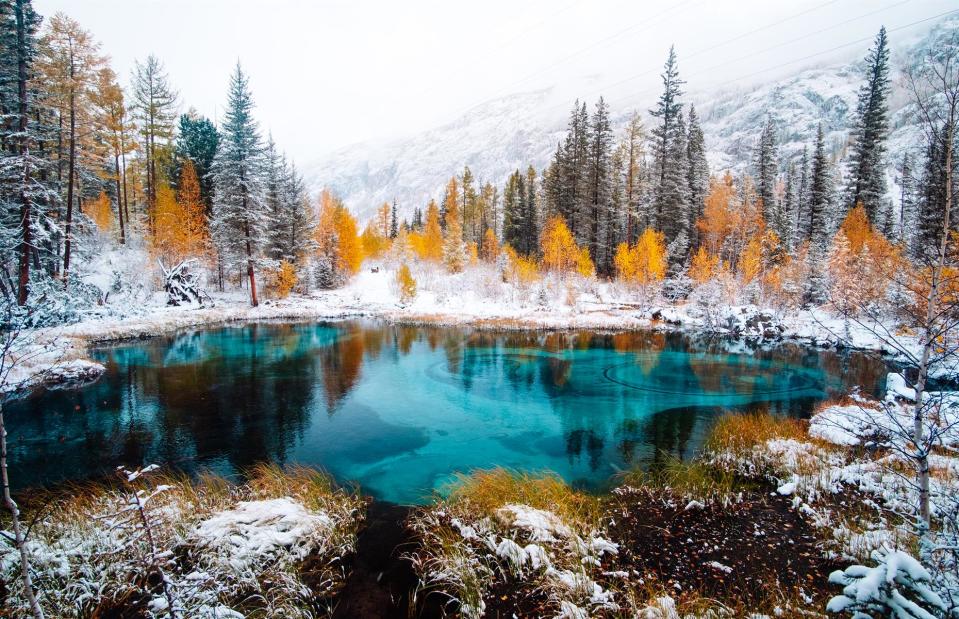
soul_studio/Shutterstock
Geyzernoye Lake, also known as Blue Lake, is located in the remote Altai Republic in Siberia. This spectacular thermal spring has vibrant teal waters and a picture-perfect surrounding landscape. Every now and then, visible concentric circles appear underneath the surface of the water, throwing out clay and sand in geyser-like eruptions.
Colmar, France
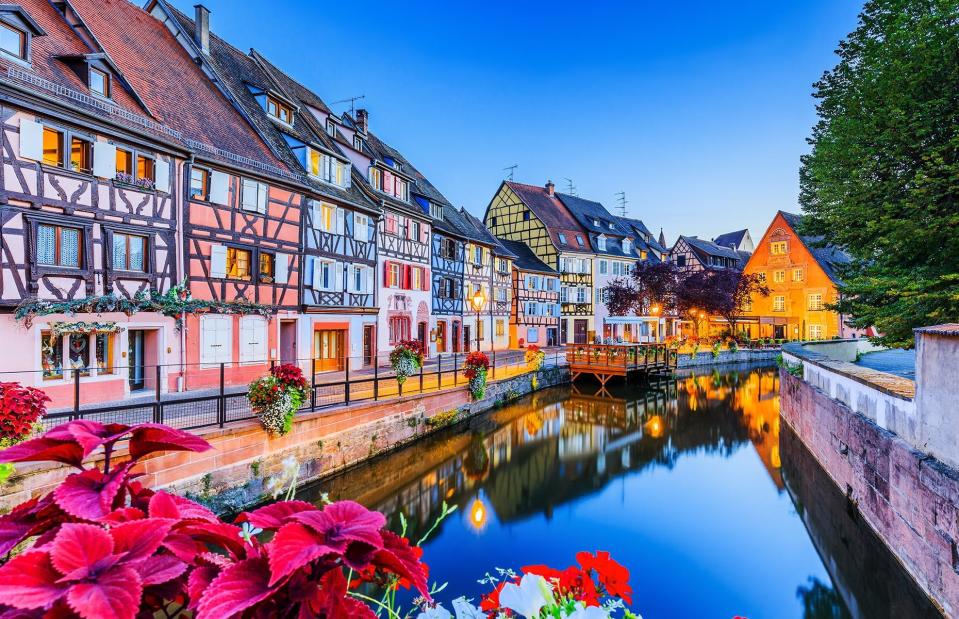
emperorcosar/Shutterstock
Winding streets, narrow canals and quaint, pastel-coloured houses – Colmar has it all. The pretty town in the Grand Est region of northeastern France is a unique collection of medieval and early Renaissance buildings, including a beautiful 13th-century church. On top of looking every bit like a fairy-tale town, it's also celebrated for being the wine capital of France's Alsace region.
Pena Palace, Sintra, Portugal
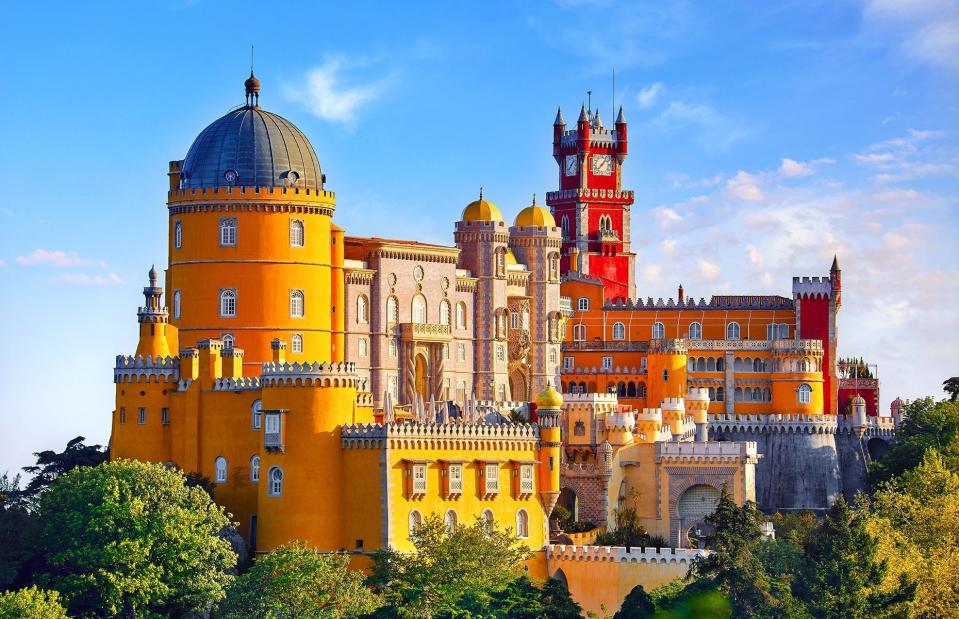
Yasonya/Shutterstock
It might be called a palace, but it is in fact a castle, and few are so heart-flutteringly pretty as Pena Palace, whose butter-yellow turrets and brick-red towers rise above the treetops in hilly Sintra, just outside Lisbon. The multicoloured beauty, an example of 19th-century Romanticism, was commissioned by King Ferdinand II and completed in 1854, and has been home to Portuguese royals through the years.
Five Flower Lake, Sichuan, China

Efired/Shutterstock
China's Jiuzhaigou Valley is on the UNESCO World Heritage list for very good reason and Five Flower Lake is perhaps its most dazzling feature. This serene lake is considered holy by many locals, thanks to its changing colours and the fact it doesn't freeze, even in winter. The mystery behind this unique wonder can be explained by science – home to hot springs, the pool also has aquatic plants which change colour when exposed to sunlight.
Cinque Terre, Liguria, Italy
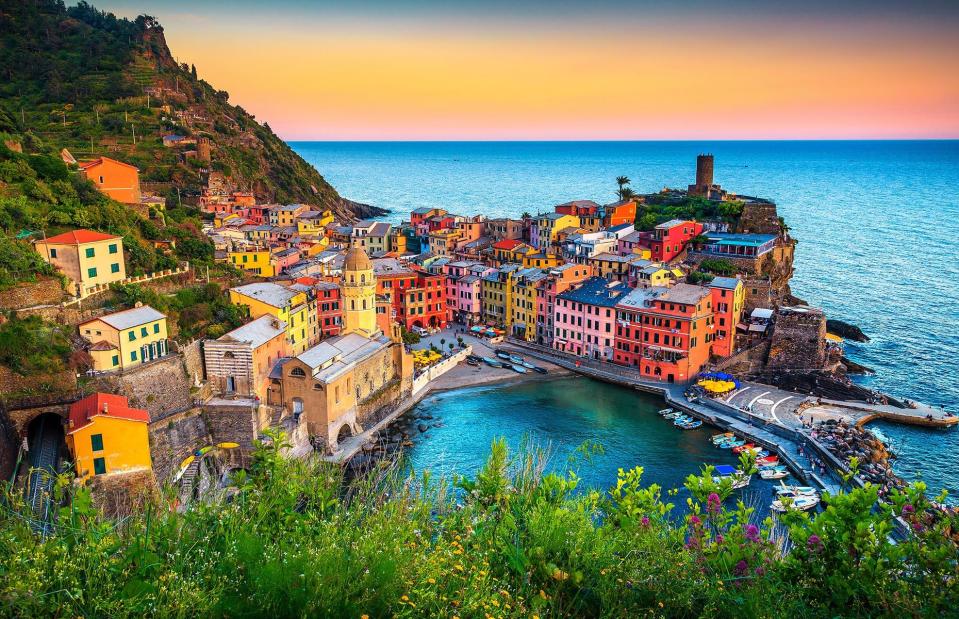
Gaspar Janos/Shutterstock
Set amid rocky coastal cliffs and blooming bougainvillea, Italy's breathtaking Cinque Terre is made up of five villages carved into the cliffside – Monterosso al Mare, Vernazza, Corniglia, Manarola (pictured) and Riomaggiore. It’s said the houses were painted in various shades so fishermen working offshore could easily see their homes. Today, the five villages are connected by a coastal walk that's part of the Cinque Terre National Park.
Nā Pali Coast, Hawaii, USA
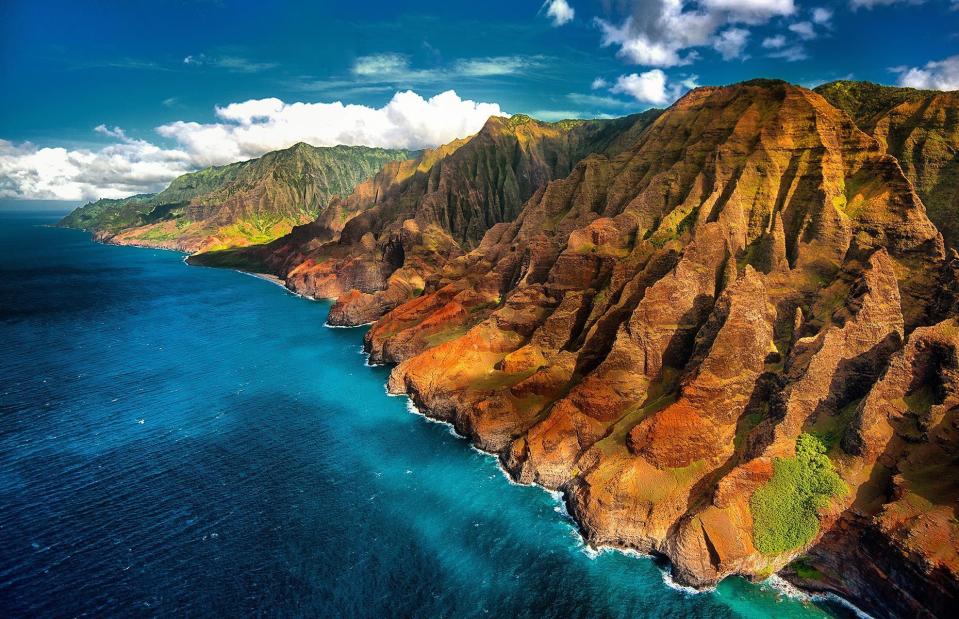
Mohamed Selim/Shutterstock
The gorgeous forest-covered cliffs of the Nāpali Coast State Wilderness Park on Kauai Island are an exquisite sight to behold. Like something straight out of Jurassic Park, some of the rugged red and green rocks of the coast look more suited to a different planet than Earth. Nā Pali means 'high cliffs' in Hawaiian – a very fitting name when the tallest mountains here soar to 4,000 feet (1,219m).
Maple trees, Québec, Canada

Pat Lauzon/Shutterstock
Fall is a colourful season everywhere in Canada, but no more so than in the province of Québec which is thronged with maple trees. The leaves turn bright orange or brilliant red, covering the rolling hills of rural Québec in a blanket of colour for several weeks in October. The trees also have a sweet season in the early spring, when their sap is tapped and turned into delicious maple syrup.
Colonia de Sant Jordi, Mallorca, Spain
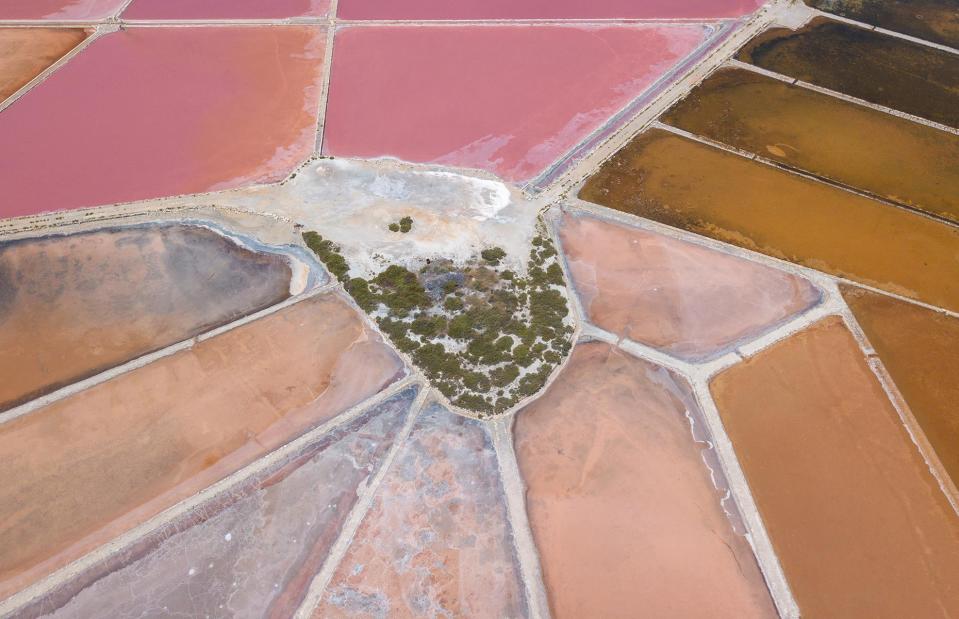
MC MEDIASTUDIO/Shutterstock
While it may look like a giant paint palette, this pink landscape is actually made up of salt flats and is situated in the seaside resort of Colonia de Sant Jordi in Mallorca's Ses Salines district. Salt is a major export here and a great source of local pride – a symbol of a salt mound even appears on the area's coat of arms. The colours – earthy pink, deep tan and rich beige – pop when captured from up high.
Landmannalaugar, Iceland
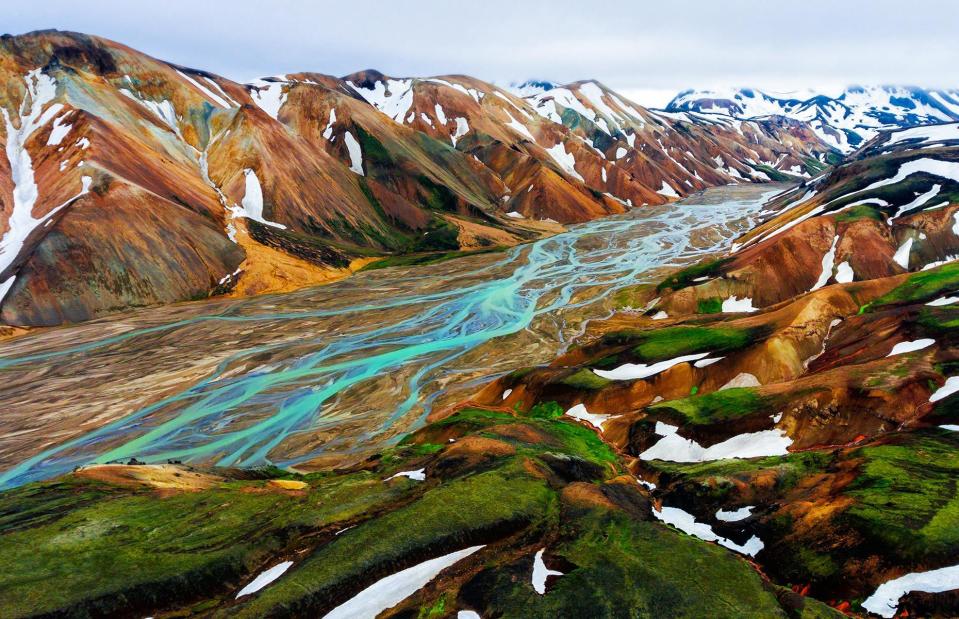
Blue Planet Studio/Shutterstock
The Highlands of Iceland are renowned for thermal springs and mirror-like fjords but Landmannalaugar is unlike anywhere else in the world. Inside Fjallabak Nature Reserve on the edge of the Laugahraun lava field, this unique and unusual landscape was formed during a volcanic eruption around 1477. Famed for its geothermal springs and azure rivers, this rugged region also benefits from candy-coloured hills that appear to be painted by hand.
Saint Basil's Cathedral, Moscow, Russia
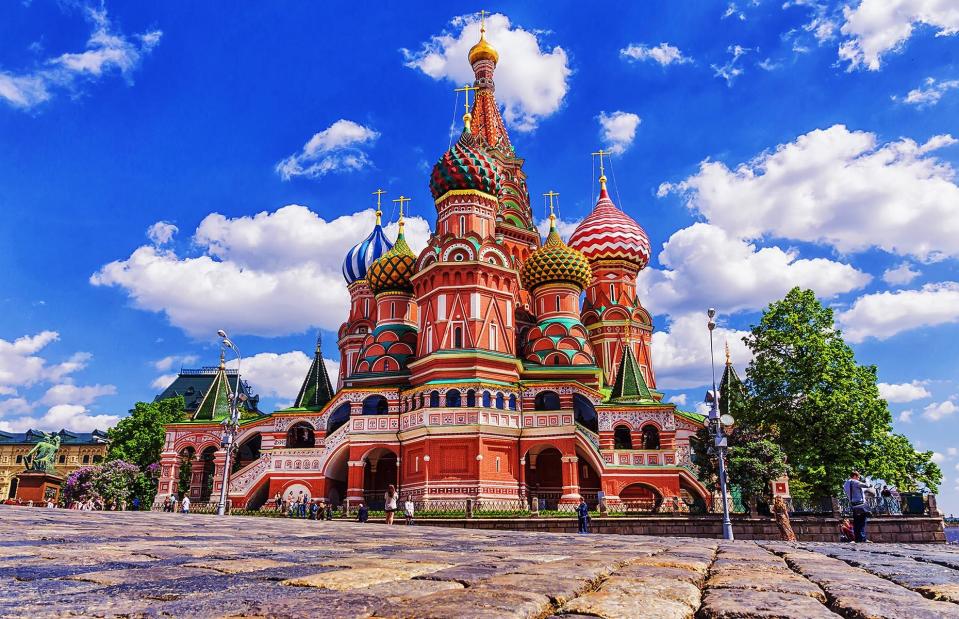
dimbar76/Shutterstock
Particularly vivid against a summer sky, Red Square's Saint Basil's Cathedral looks like something out of a fairy tale. With its stripes, spots and iced-gem turrets, not to mention multitude of colours, it's one of the best-known cathedrals in the world for a reason. One of Moscow's most recognisable landmarks, the ornate building in Red Square was designed to resemble the flames of a bonfire.
Ningaloo Marine Park, Western Australia, Australia
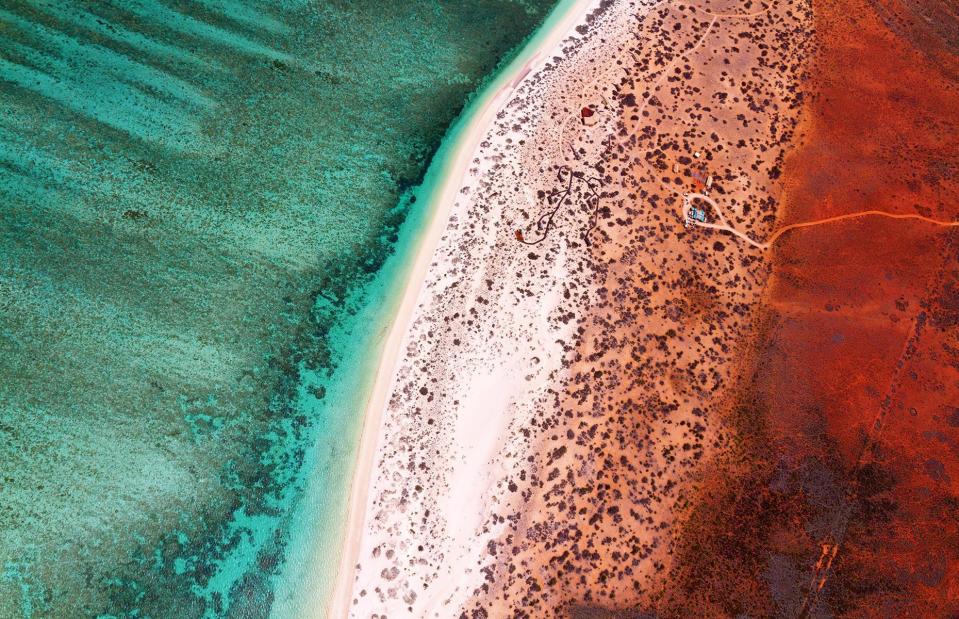
Darkydoors/Shutterstock
The Ningaloo Marine Park off the shores of Exmouth hugs more than 160 miles (257km) of Western Australia's coastline, and is home to more than 500 species of fish and 200 types of coral. From this eagle viewpoint, you can see how the cyan waters meet the pale shores of Cape Range National Park, known for its sandy beaches, rugged gorges and orange rockscapes.
Júzcar, Málaga, Spain

cineuno/Shutterstock
For most of its history, this small Spanish town in the province of Málaga was simply a village with whitewashed homes, like many others in Spain. Then, in 2011, Sony executives painted the houses blue for a publicity stunt to promote The Smurfs movie. Afterwards, Sony offered to paint the town back, but the 221 citizens of Júzcar voted to keep it blue.
Little India, Singapore

Luciano Mortula - LGM/Shutterstock
Jam-packed with shops, street markets and bright buildings, Little India really is a slice of the subcontinent in Singapore. Located near the Serangoon River, Indian immigrants have replicated their homeland with colourful buildings and temples. More often than not, a mouthwatering smell of Indian street food fills the air and during the Hindu celebration of Diwali, the area is at its most vibrant.
Paraty, Brazil

Catarina Belova/Shutterstock
Located on the Costa Verde, a coastal area in the state of Rio de Janeiro known for its greenery, Paraty is one of the oldest towns in Brazil. Founded in 1667 by the Portuguese, its colourful center is now an UNESCO World Heritage Site and is fully pedestrianised – a further bid to preserve the town's already immaculate historic buildings. Much of the town's architecture, including the cobbled streets, hasn't changed much for 250 years or more, leaving an impression you've traveled to a different era entirely.
St John’s, Newfoundland, Canada
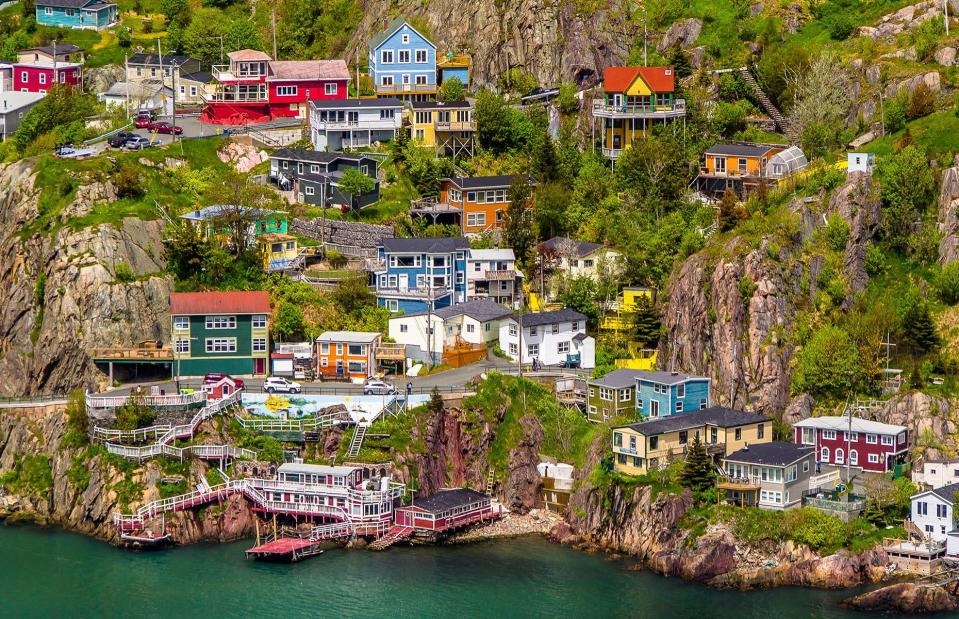
Jarmo Piironen/Shutterstock
St John’s is the oldest city in North America, established around the turn of the 16th century. But the weight of its history sits lightly about the city, which feels more like a laid-back small town. Dotted along the waterfront and in the city center are brightly-painted row houses, and at the southern edge of the sheltered harbour is a squat little lighthouse. Signal Point is one of the best spots for views across the city and out over the Atlantic.
Gamla Stan, Stockholm, Sweden
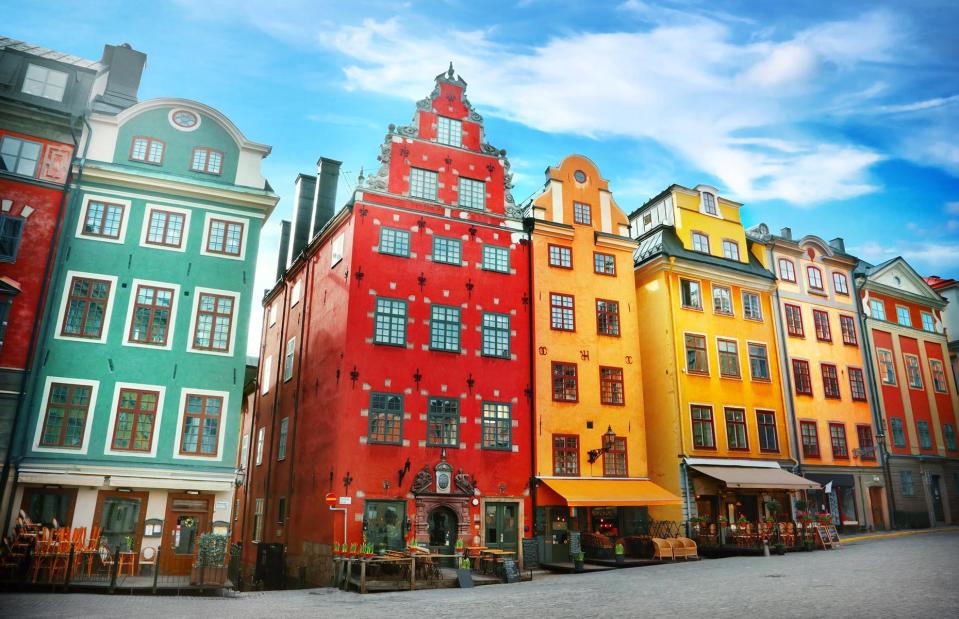
Adisa/Shutterstock
The Old Town of Stockholm was founded back in 1252 and today the winding cobblestone streets and gold and russet medieval buildings still stand, alongside newer constructions, painted in greens and oranges. Its most famous sight though is Stortorget (pictured), a cobblestone square dating back to the Middle Ages, that usually hosts the annual Christmas market and is home to the famous row of colourful buildings.
Wrocław, Poland
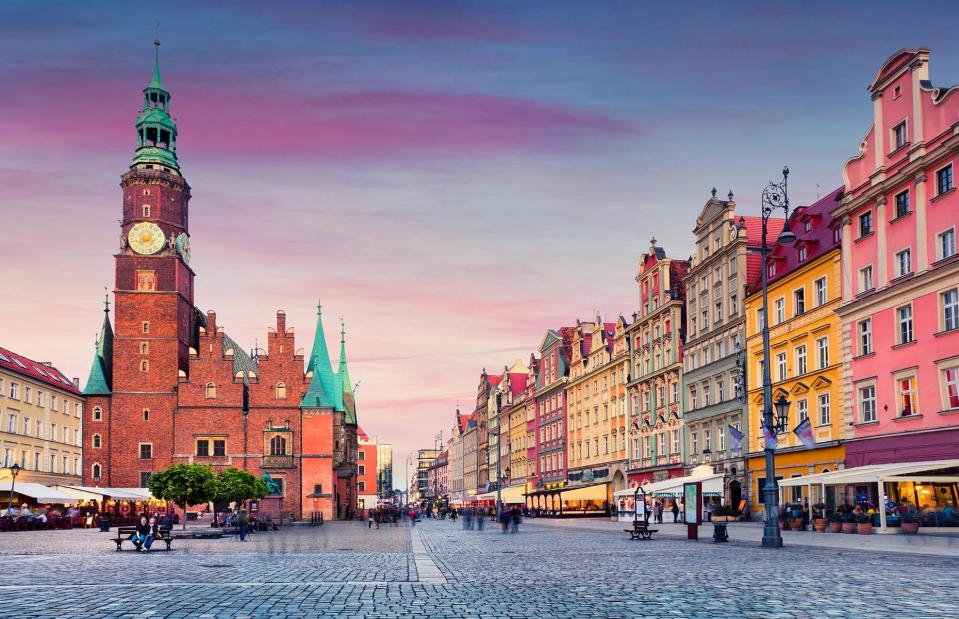
Andrew Mayovskyy/Shutterstock
With its pretty riverside location, relaxed university town feel and grand historic buildings, it’s hard to fathom why Wrocław in southwest Poland isn’t a more popular city jaunt. The sprawling Market Square is a great place to get to know the compact and easily walkable city. It was heavily hit during the Second World War but its ancient buildings and squares have been painstakingly restored. Curiously, there are more than 400 little statues of dwarfs dotted around the quirky city and there's typically a festival every September celebrating them.
Khiva, Uzbekistan

monticello/Shutterstock
Encircled by walls laid in the 10th century, Itchan Kala (Khiva’s Inner City) has a singular collection of historic buildings, giving a fascinating insight into Central Asian Islamic architecture. But more than any individual sight – the squat Kalta Minor Minaret, sumptuous Tosh Hovli Palace or ornately-tiled Pahlavon Mahmoud Mausoleum – Itchan Kala’s most astounding feature is how cohesive it feels. Its perfect pairing of brick and mosaic seeming undisturbed by the trappings of modern life.
Parga, Greece
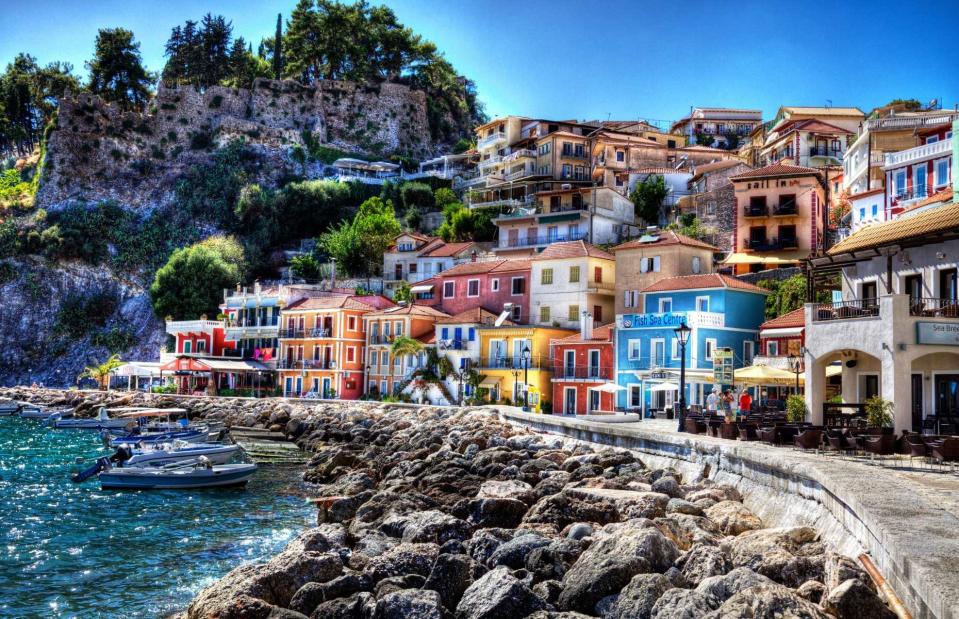
Paul Thompson/Alamy Stock Photo
Also known as the Bride of Epirus, Parga is relatively young for a Greek settlement, having only existed since the early 13th century. Despite this, the town in northwestern Greece still brims with history – it was the only free Christian village in the region during the Ottoman rule. A dilapidated fortress called the Venetian Castle is perched on a hilltop overseeing the hued homes and is a reminder of the time when the town fell under Venetian rule.
Izamal, Yucatán, Mexico
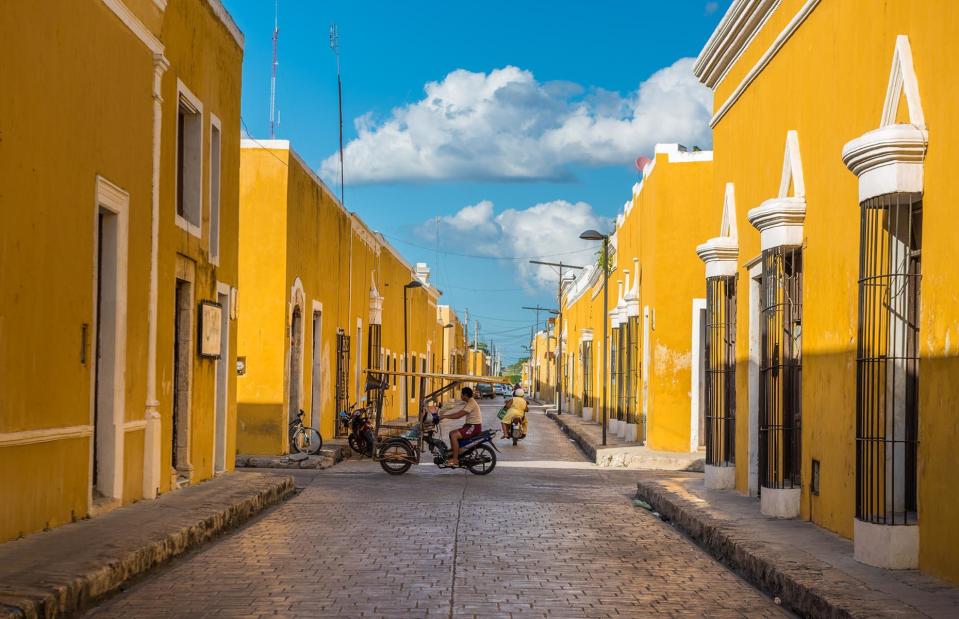
javarman/Shutterstock
In ancient times, Izamal was a center of worship for the sun god Kinich-Kakmó but it was almost all but abandoned with the rise of Chichén Itzá. Fast forward to the 16th century and a Spanish city was founded atop the existing Maya one. Located in the Yucatán region, the town is fondly referred to as 'The Yellow City' thanks to its marigold buildings.
Xwejni salt pans, Gozo, Malta
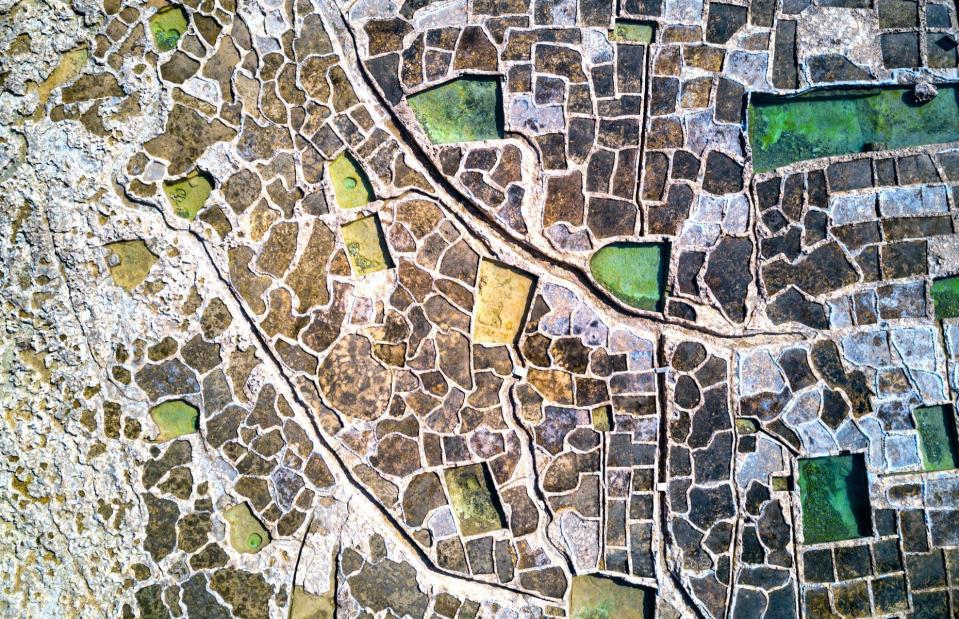
Nicholas Courtney/Shutterstock
The pretty Maltese island of Gozo is famous for its Neolithic sites and rugged stretches of coastline, but it's also notable for its salt production and in the north you'll find large clusters of salt pans. They're at their most picturesque when seen from above: the pans appear like a mosaic with hues of earth brown, white and sand, punctured by emerald-green water.
Bergen, Norway
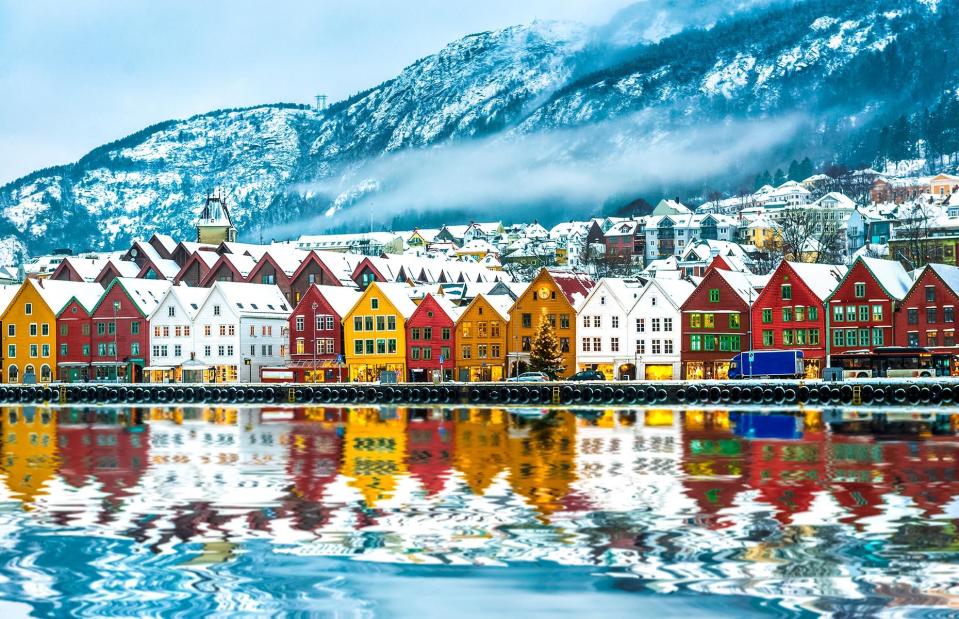
Tatyana Vyc/Shutterstock
Although it’s beautiful in every season, Bergen really comes into its own as the days grow shorter and the snow piles up. Its coloured houses cling to the mountainsides, seeming to huddle together against the cold, reflecting perfectly in the clear waters of the North Sea. Bergen may be known as the gateway to the fjords, but there’s plenty of beauty to be found within the city too.
Kinsale, County Cork, Ireland

Geoffrey B. Johnson_Media/Shutterstock
The Irish coastal town of Kinsale is famed for its exceptional cuisine, which showcases the best of the bounty from the Celtic Sea. Besides the fanciful food on offer, Kinsale is also known for its quirky streets which are flamboyantly painted every colour of the rainbow.
Porto, Portugal
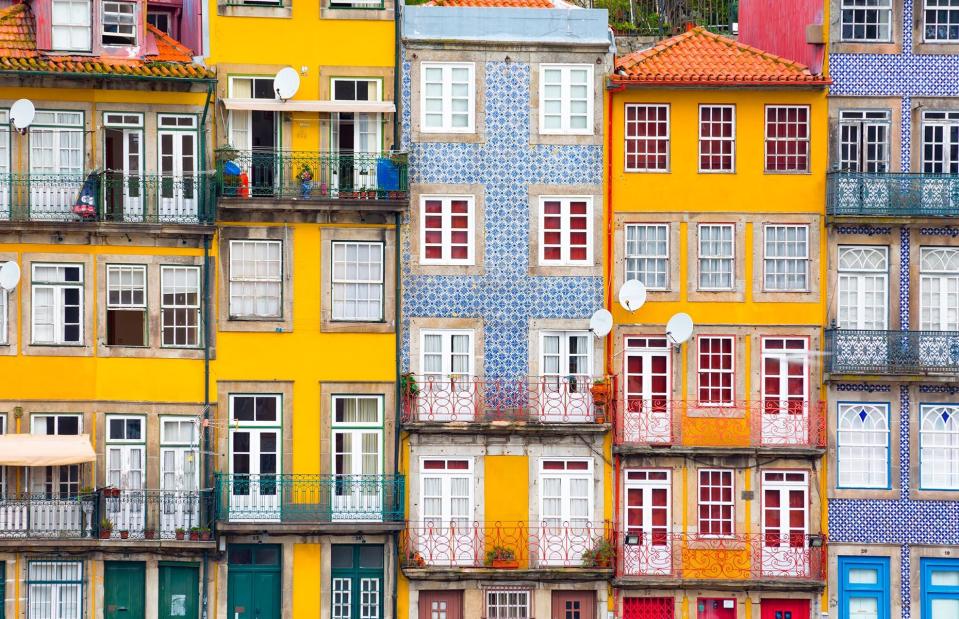
Zhukova Valentyna/Shutterstock
Lisbon gets most of the attention but Portugal’s second city is uniquely beautiful and atmospheric, especially in its medieval Ribeira district. Here, centuries-old merchants’ and mariners’ homes line cobbled streets, seeming to crane their necks over each other to get a view of the Douro River. In fact, the whole town seems focused on the river and its grand bridges – from the double-decker Ponte de Dom Luís I to the sleek, modern Ponte de São João.
Havana, Cuba
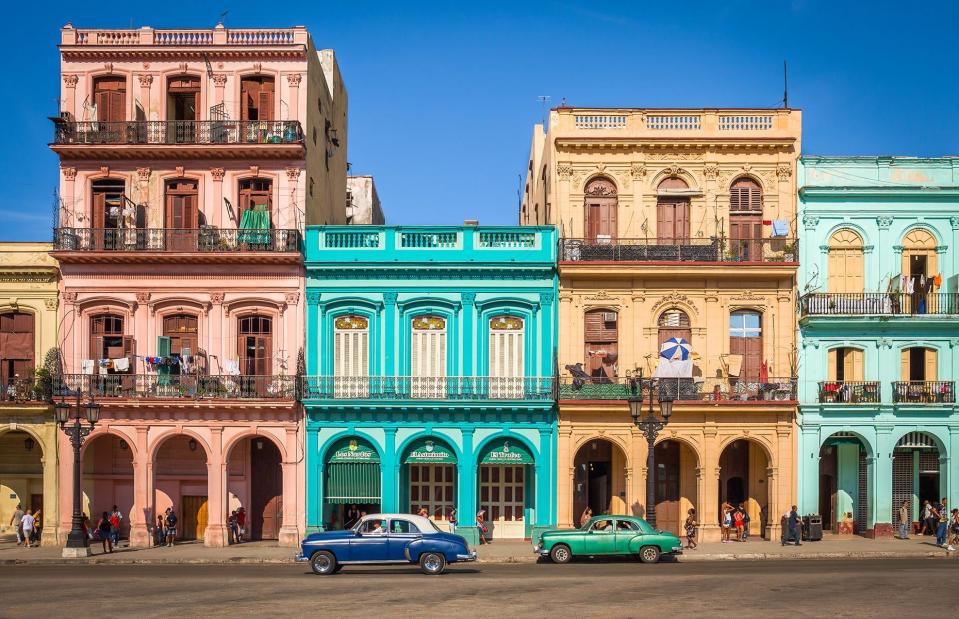
Maurizio De Mattei/Shutterstock
Havana’s faded grandeur is famous for a reason. The wide avenues, lined with bright, peeling buildings; laundry hanging from wrought-iron balconies; plants growing on and occasionally out of windowsills; the wide plazas, ornate churches and eye-catching murals. Havana is a jumble of so many different elements that it shouldn’t quite work – but somehow, it all comes together to create something unforgettable.
Yuanyang rice terraces, Yunnan, China
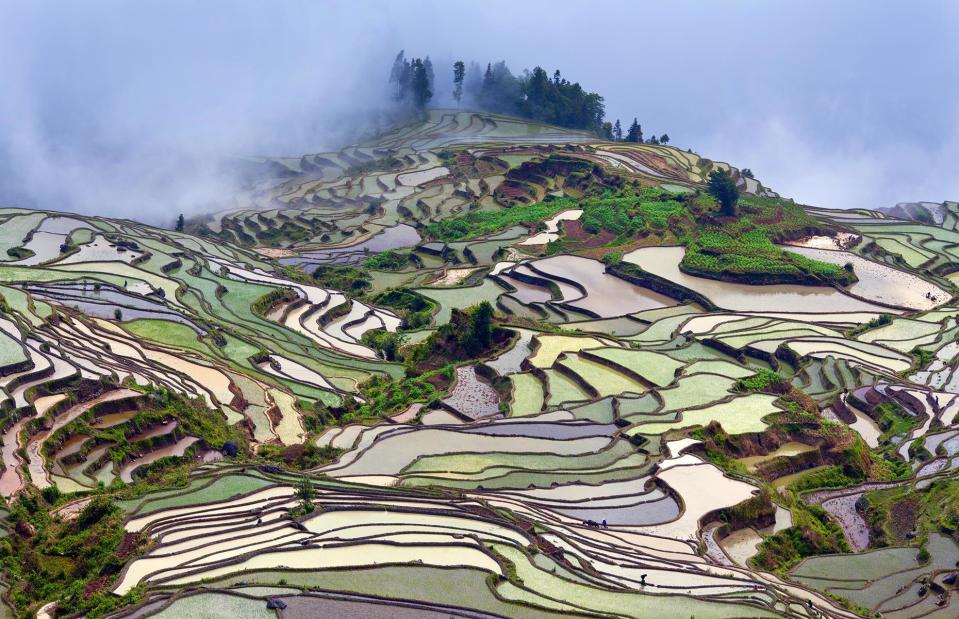
Zzvet/Shutterstock
These vibrant rice terraces in China's Yuanyang County have been an UNESCO World Heritage Site since 2013 and no wonder. Built on red-soil mountains over 2,500 years ago and reaching up to 6,561 feet (1,999m) above sea level, the undulating landscape and agricultural patchwork fill with cascading spring water from the forests above, creating a unique pattern in shades of green and brown.
Burano, Italy
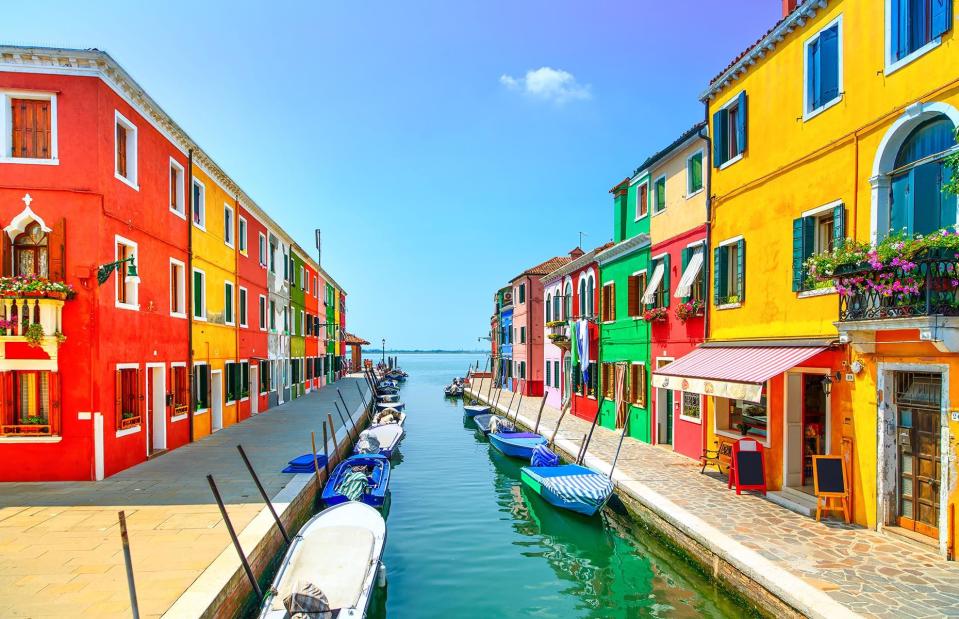
StevanZZ/Shutterstock
Looking out to the Venetian Lagoon, Burano's bright houses line the streets and canals in a colourful maze. It's thought that the island got its signature look when fishermen painted their houses as bright as possible, so they would be easier to spot in the thick fog so common on the lagoon. A popular day-trip destination from Venice, Burano is also famous for its lace work.
Comfort Town, Kyiv, Ukraine
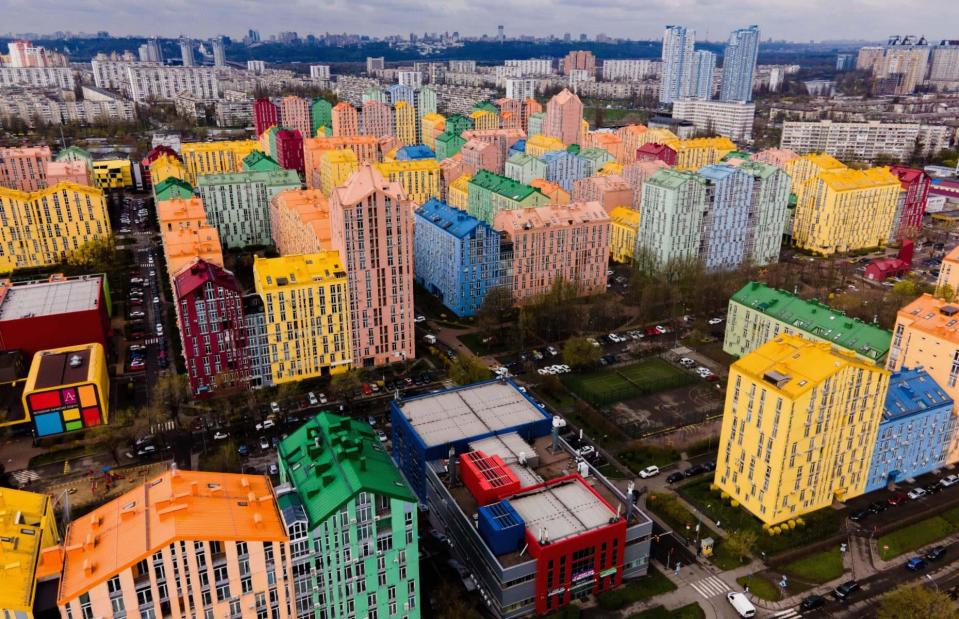
Christopher Kane/Alamy Stock Photo
Standard social housing blocks found in Ukraine’s capital, created during the Soviet era, are notorious for being identikit and utilitarian-looking. But not in Comfort Town. This 40-hectare plot in the heart of Kyiv stands out for its rainbow-coloured buildings, which almost look like they’re made from children’s building blocks. The development was created by architecture firm archimatika, who wanted to create mood-boosting, affordable housing.
Kampung Pelangi, Semarang, Indonesia
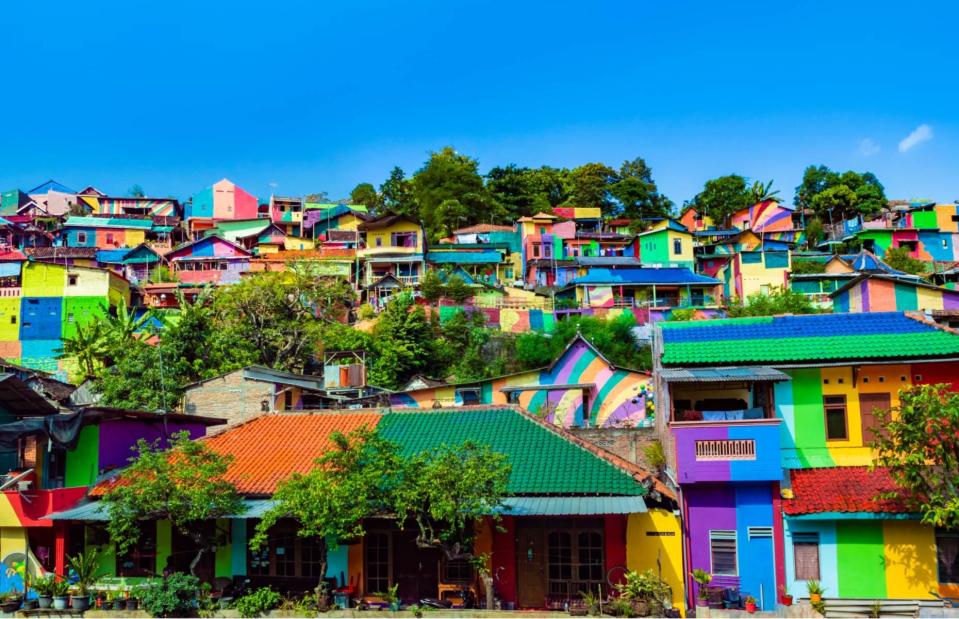
Hani Santosa/Shutterstock
Proving that a lick of paint can make the world of difference, in 2017 a small village in south Semarang on Java in Indonesia, underwent a dramatic transformation. Backed by a government loan, Kampung Pelangi had a colourful makeover in the hope of attracting more visitors. It seems their plan worked, as Instagram is flooded with pictures of the town – today nicknamed 'Rainbow Village'.
Chefchaouen, Morocco
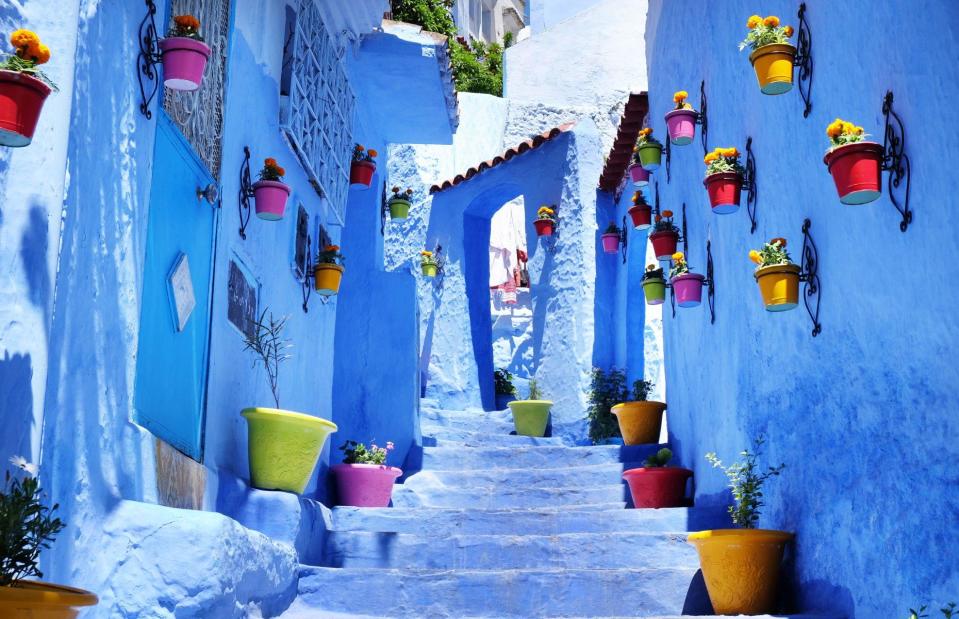
Vixit/Shutterstock
Located beneath the towering peaks of the Rif Mountains, Chefchaouen is a labyrinth of intricate alleyways. Soaked in a turquoise hue, the electrifying colours have a historical significance: in the 15th century, Jewish refugees settled in the area and painted buildings blue to mirror the sky and remind them of God. Today, one of the city's most famous sights is the steps pictured here, where colourful plant pots sit in beautiful contrast to the blindingly blue walls.
Grand Prismatic Spring, Wyoming, USA
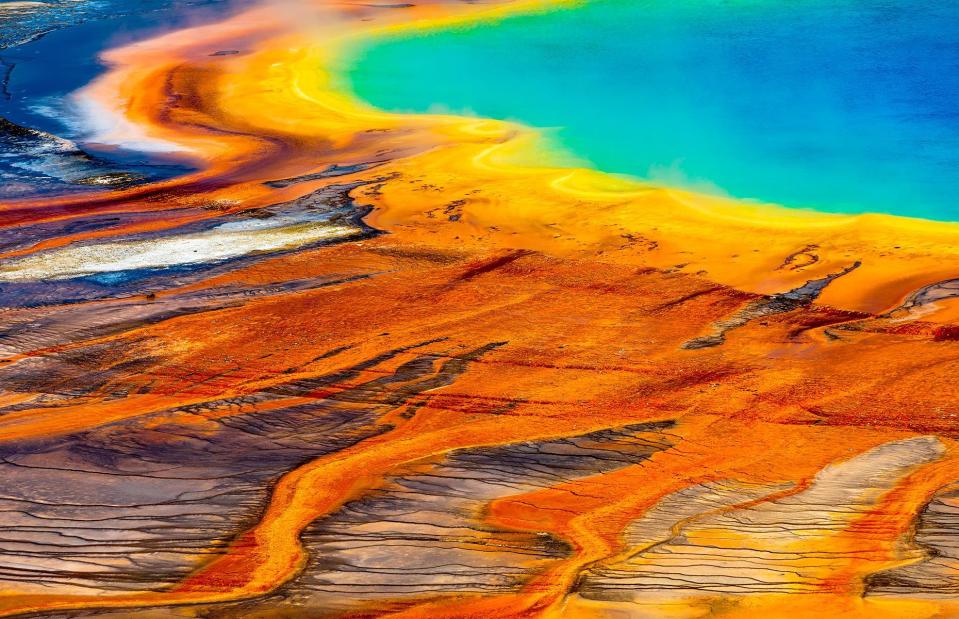
Anders Riishede/Shutterstock
Yellowstone's most famous hot spring, the Grand Prismatic's vivid blue centre is surrounded by bands of rusty orange, yellow and green, making it look otherworldly. The largest hot spring in the United States and the third largest in the world, Grand Prismatic's water reaches a temperature of around 70°C. Multi-layered sheets of microorganisms called microbial mats give the bands their distinctive colours, that tend to change slightly with the seasons.
Guatapé, Colombia
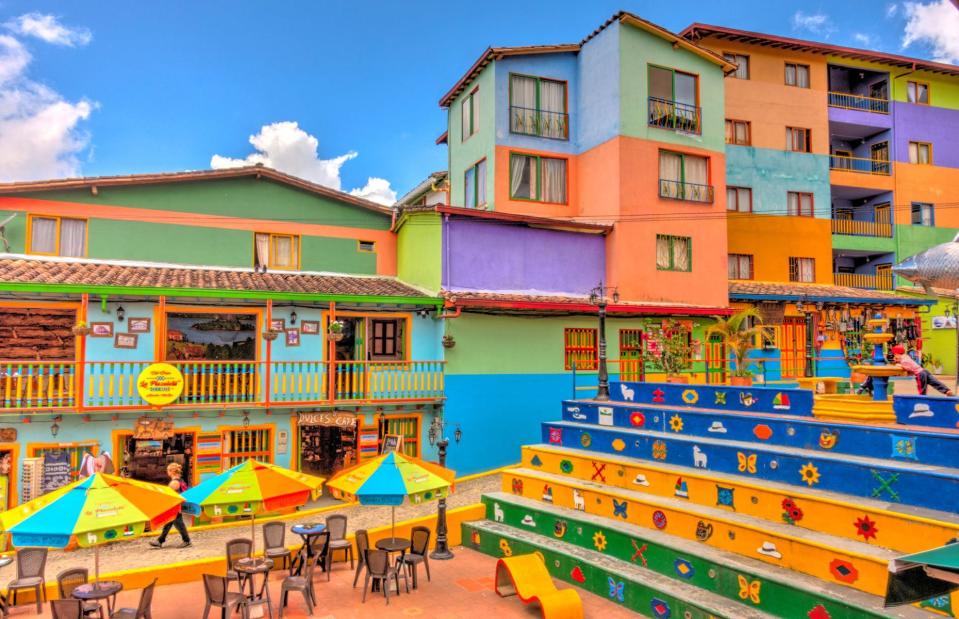
mehdi33300/Shutterstock
A two-hour drive from Medellín, the town of Guatapé is known as Colombia’s most colourful. What started out as a farming and mining town, today attracts visitors with its cheerfully-painted streets. Each of its vibrant buildings is decorated with zocalos – intricate panels depicting different aspects of village life – and while no one quite knows why the tradition began, they’re utterly mesmerising.
Procida, Campania, Italy
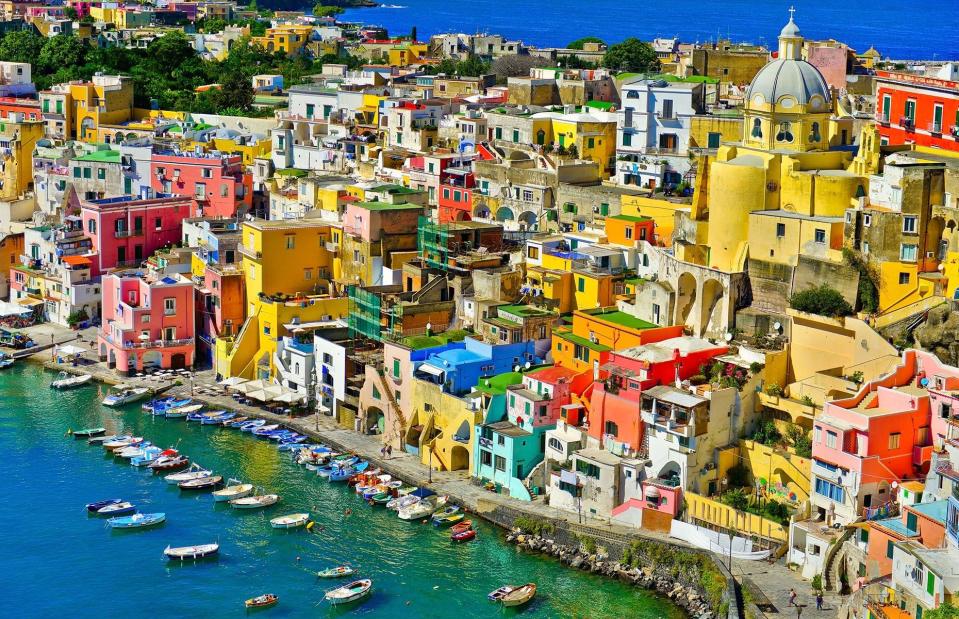
Javen/Shutterstock
The town of Procida spans the whole island from which it gets its name. It’s the Bay of Naples’ smallest and sweetest island, much quieter than its neighbours like Capri. Littering the coastline are houses drenched in dazzling shades of pink, blue, yellow and more, their peeling paintwork adding to the effortless Italian charm.


